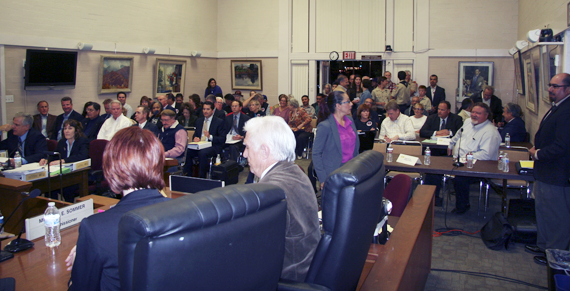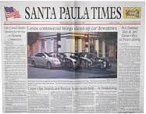
|
It was standing room only at Tuesday’s joint City Council and Planning Commission meeting where the Supplemental EIR and revised development plan were approved. Limoneira officials are hoping ground will be broken on the project this year. |
Amended specific plan for East Area 1 approved by PC, City Council
February 20, 2015
By Peggy Kelly
Santa Paula News
With plenty of fanfare and not much discussion the Planning Commission and City Council unanimously approved the amended specific plan for the 501-acre East Area 1, Limoneira's planned residential and commercial development east of Hallock Drive.
The joint panel also approved the accompanying development agreement, map and environmental impact report for the project, which will create 1,500 housing units and amenities.
Before the hearing started in the standing-room-only City Council chambers Mayor John Procter and Planning Commissioner John Wisda recused themselves from the vote. Procter noted his family’s longtime involvement in Limoneira in which he now holds shares he inherited from his father. Vice Mayor Martin Hernandez took the gavel for the hearing.
Wisda read a statement noting his longtime concern about the drought and dwindling water supplies for new development and the perception he might be biased, which would be a conflict. Although he disputed that concern Wisda said he would step down from the hearing.
Planning Director Janna Minsk and consultant Tony LoCasio gave a brief report on the changes in the Supplemental EIR as well as the development agreement.
The development will be built on Limoneira property north of Highway 126 and divided into three neighborhoods, with a variety of homes, parks and an elementary school with more land set aside for a high school.
Almost half of the project property is designated for parks and open space, including a 37-acre community park, 55 acres of neighborhood parks and greenways, and a like size agricultural preserve.
Voters overwhelming approved the project by more than 82 percent in 2007 and the next year city officials approved the specific plan that now has reduced commercial and industrial space from 435,000 square feet to 240,000 square feet.
The revised plan also eliminates plans for a $5 million civic facility but Limoneira now will deposit the money with the city, which could decide later to use the funds for a civic center and/or amphitheater.
Limoneira President and CEO Harold Edwards noted the company is solidifying its legacy of community development with the project, “One of the most historical moments in the company’s 123-year history.”
Company management, directors and shareholders express “extreme gratitude for all the work you’ve done, your predecessors and the whole community,” that supported the project.
He noted his own ties to the area where his father was a popular physician and family rancher: “I basically grew up in Santa Paula and feel this community is my community,” that he feels very fortunate to have been a part of and return to after an international career.
Although there had been talk about eventual development east of the city it wasn’t until about 2004 when Edwards - who had just joined Limoneira - was approached by then City Manager Wally Bobkiewicz.
“During that meeting he introduced to me what I thought was a radical idea,” to annex the property into the city “to advance the methodical and organized” expansion of the city in a way that would benefit the community.
To ensure there was a long, public planning process with design charrettes and careful study of potential environmental impacts.
The plan was presented to the council in 2006, and “Then we got to face the most daunting part of the process,” garnering required approval at the ballot box from Santa Paula citizens.
What resulted was the election required by SOAR, which had been created to give citizens more say in development.
“SOAR had never been successfully passed by a developer,” but voters approved Limoneira’s plan by 83 percent, which Edwards said “really spoke volumes about our ability to listen.
“Then,” he joked, “it was easy,” with a three-year effort to change greenbelts and overcoming other regulatory hurtles on the way to development.
After 11 years and a $55 million investment, “We made it our goal to make sure that most of the work to create this,” will provide local jobs and opportunities.
Edwards said it is now, “Santa Paula’s turn” to prosper.
Speakers agreed including labor representatives still smarting after being shut out of the 2008 contract to construct the city’s new $62 million wastewater treatment plant.
Rodney Cobos of Santa Paula representing the Plumbers and Pipefitters Union told the panel he was “excited to hear the plan includes the commitment to local workers... no doubt citizens of this community, all workers deserve to work on this project. There’s a difference to bringing jobs to Santa Paula and bringing local jobs to citizens of Santa Paula,” and past practices have paid others less to take home elsewhere.
“Paying the worker less money won’t make the houses less expensive,” said Cobos so, “let’s invest in that worker... when working families work and prosper everybody wins.”
Although others voiced their support of the project some had caveats - Delton Lee Johnson noted that the Ventura County Community College District expressing no interest in Santa Paula was business as usual - while others were critical questioning aspects of safety and the environment.
Civil engineer Nina Danza of Ventura addressed storm drain and run-off issues and noted new policy should be studied or else harm would come to the Santa Clara River ecosystem and the water quality.
Sheryl Hamlin of Santa Paula said several issues had not been mitigated including emergency traffic demands on the project’s two ways of ingress/egress, the lack of recycled water the project is slated to rely on and erroneously high population predictions.
Some Planning Commissioners asked for clarification on issues brought up by speakers. Although Commissioner Fred Robinson said the city would benefit from sales tax revenues Commission Chairman Ike Ikerd cautioned against construction related traffic disruptions.
After the commission voted 4-0 in favor it was the council’s turn and they all echoed in one way or the other remarks made by Councilwoman Ginger Gherardi, who first pointed out some needs in the fine points of the document.
She noted, “The time has come,” for East Area 1, and much like the community, which is eager for it to finally become a reality, “I am very much looking forward to this project.”



